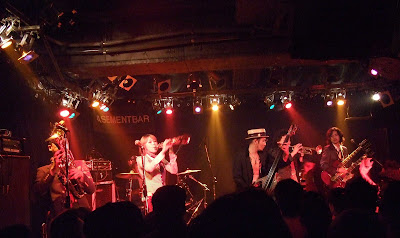 Their long-awaited new work, the EP “Shiroi Asa” (White Morning), shows off advantage Lucy's musical range. The EP features a ballad, a fun pop tune, and a rocker—each sounds great, and even though the songs are so different in feel, they blend together perfectly like some three-Michelin-star three course dinner.
Their long-awaited new work, the EP “Shiroi Asa” (White Morning), shows off advantage Lucy's musical range. The EP features a ballad, a fun pop tune, and a rocker—each sounds great, and even though the songs are so different in feel, they blend together perfectly like some three-Michelin-star three course dinner.The first song, the title track, follows a long line of standout ballads by advantage Lucy. What's especially striking about it is the way vocalist Aiko stretches out the syllables of the words—the start of the tune sounds like “iiiiii, tsumooooo, omoooote taaa (always, I thought)” —and with these extensions she seems to infuse the lyrics with more meaning, at the same time that she puts on display the clear beauty of her voice.
Song number two, “my little holiday”, is advantage Lucy's “Penny Lane”: a sunny pop song that celebrates a town, in this case the “500-meter radius” surrounding the singer's home, the site of her mini-vacation. It begins with sounds from one of those Tokyo streets filled with little, aging shops, and Aiko's voice is heard ordering a hamachi, yellowtail, from a shopkeeper lady. Guitarist Yoshiharu Ishizaka, who composes the songs, obviously had fun with this tune: it's a colorful melange of sounds, including some sort of xylophone and recorder, as well as a cat's purr and a parakeet's screech.
“Mimi wo sumasete”, the last song, is a rocking number that you might hear on the radio in an alternative universe world where good songs fill the radio waves. In any case, it is on MY radio station.
At the same time that advantage Lucy is a great musical group, they're also an art-minded bunch, as is apparent looking at this CD's booklet: it's made of a special type of paper that lets you punch out little letters, and those letter shine when you put it up against a light.
Advantage Lucy is selling this extended play CD only at shows and from its website, and it's a limited edition of 1,000 disks. I'm not sure how you can buy it if you're outside of Japan, but am looking into it.
***
Traveling back in time a bit, the show where I bought the CD was on May 20 at the Que, and it was one of those knock-out advantage Lucy gigs where time passes happily, and the memory of it lingers for days afterwards. The new advantage Lucy band, with a new bassist and drummer, is becoming tight. They played all three songs from the new CD in succession.
It was a two-band show, with Freenote, a group I've been interested in for a few years led by a fine-voiced female vocalist. She played both the keyboards and guitar, but I liked it better when she was on the latter, because then she faced the audience—there's something important about that, looking straight at the crowd at these small clubs, that sense that you're sharing with people something they should really know and hear. Advantage Lucy is also a band that makes you feel at gigs that they are sharing with you a vital musical message.

(fun with graphics software...)
 I went to see
I went to see 
 The groovy cats were all there at the Basement Bar to see four bands brought together by a guy named Little Elvis Ryuta, and the first act was a duo called
The groovy cats were all there at the Basement Bar to see four bands brought together by a guy named Little Elvis Ryuta, and the first act was a duo called 
 Moving on, the third act was the organizer of the event,
Moving on, the third act was the organizer of the event, 

 Why did the
Why did the